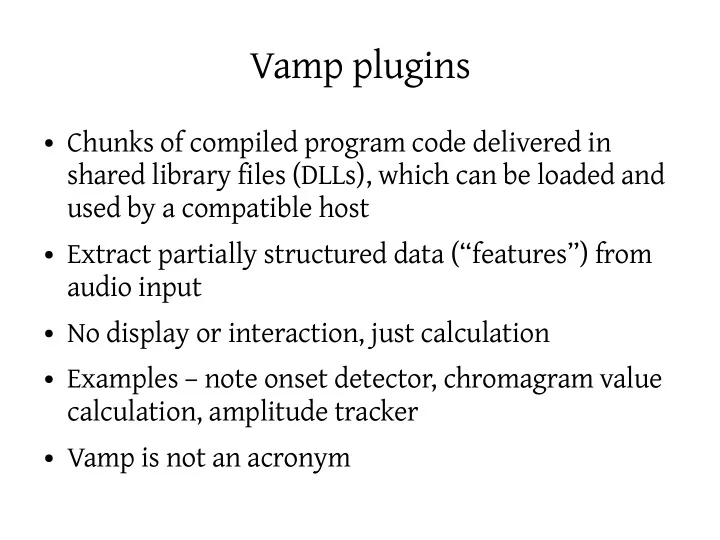

Vamp plugins ● Chunks of compiled program code delivered in shared library files (DLLs), which can be loaded and used by a compatible host ● Extract partially structured data (“features”) from audio input ● No display or interaction, just calculation ● Examples – note onset detector, chromagram value calculation, amplitude tracker ● Vamp is not an acronym
A Plugin in its Natural Habitat
Philosophical notes ● Nothing very clever about Vamp; it just fills a need ● Much drawn from existing audio processing APIs ● Complications mostly from the fact that a plugin may legitimately want to return almost anything ● Classic data description problem: – How far do the plugin and host need prior mutual understanding about the meanings of the data being returned? – Where to draw the line between “a fixed set of possible feature types” and “anything at all”?
Things a Plugin May Need ● Always – Basic descriptive data: Identifier, name, description, maker etc – Processing preferences: Input domain, step size, block size, channel count – Output descriptors – process and getRemainingFeatures methods ● Sometimes – Parameters: descriptors, get and set methods – Programs: list of names, get and set methods
Plugin Lifecycle 1. Plugin library loaded 2. Plugin object constructed, with sample rate 3. Host queries: outputs; preferred input step & block size, domain, channel count; parameters & programs 4. Parameters and programs set 5. Plugin initialised with step & block size, channels 6. Repeated calls to process 7. One call to getRemainingFeatures
Processing – time domain input
Frequency-domain input
What does a plugin return? ● Plugin may have many outputs, and always calculates all of them: host doesn't choose up front ● Each call to process or getRemainingFeatures may return zero or more “features” per output ● A feature has – Time (implicit or explicit) – Zero or more values – An optional label ● Empty features are perfectly valid
What does a feature represent? ● Something that happened at a particular time – Note onset – Column of data for a chromagram plot – Amplitude estimated from a particular region of input ● Time may be – Explicit : timestamp in the feature object – Implicit : deduced by the host based on the time in samples of the data passed in to process – this depends on the “sample type” for the output
Values of a feature ● A feature may have values associated with it – Note onset (from simple onset detector) has no values – Column of chromagram data has lots of values – Amplitude has one value ● Host's understanding of the “meaning” of a feature depends on which output it is returned on ● Output descriptor may supply units, bin labels (for multi-value features), minimum/maximum extents ● In future: known feature types via RDF
Some Limitations ● All values in a single feature must have same unit – Many real examples of features as points in multidimensional space are not comfortably handled – No proper way to express “duration” of a feature, a very common requirement ● No inputs other than audio – no plugin chaining ● Partial input blocks not supported – host has to zero-fill last block, can't tell plugin it is incomplete
Pros and Cons compared with Matlab ● Pros – Can be used in many different host applications – Doesn't require big commercial supporting framework – May run faster or handle larger data sets ● Cons – Useless without a host – Needs to be recompiled for every target platform – Familiarity with C or C++ required – Things Matlab does by magic have to be written by hand – Algorithm must support block-by-block processing
More ● Website: – http://www.vamp-plugins.org/ ● Forum (complaints and announcements): – http://www.vamp-plugins.org/forum/ ● Programmers Guide coming up “any day now”: – http://www.vamp-plugins.org/develop.html – just as boring as this presentation, but much longer ● Vamp SDK v1.2 out this week as well, perhaps
Recommend
More recommend